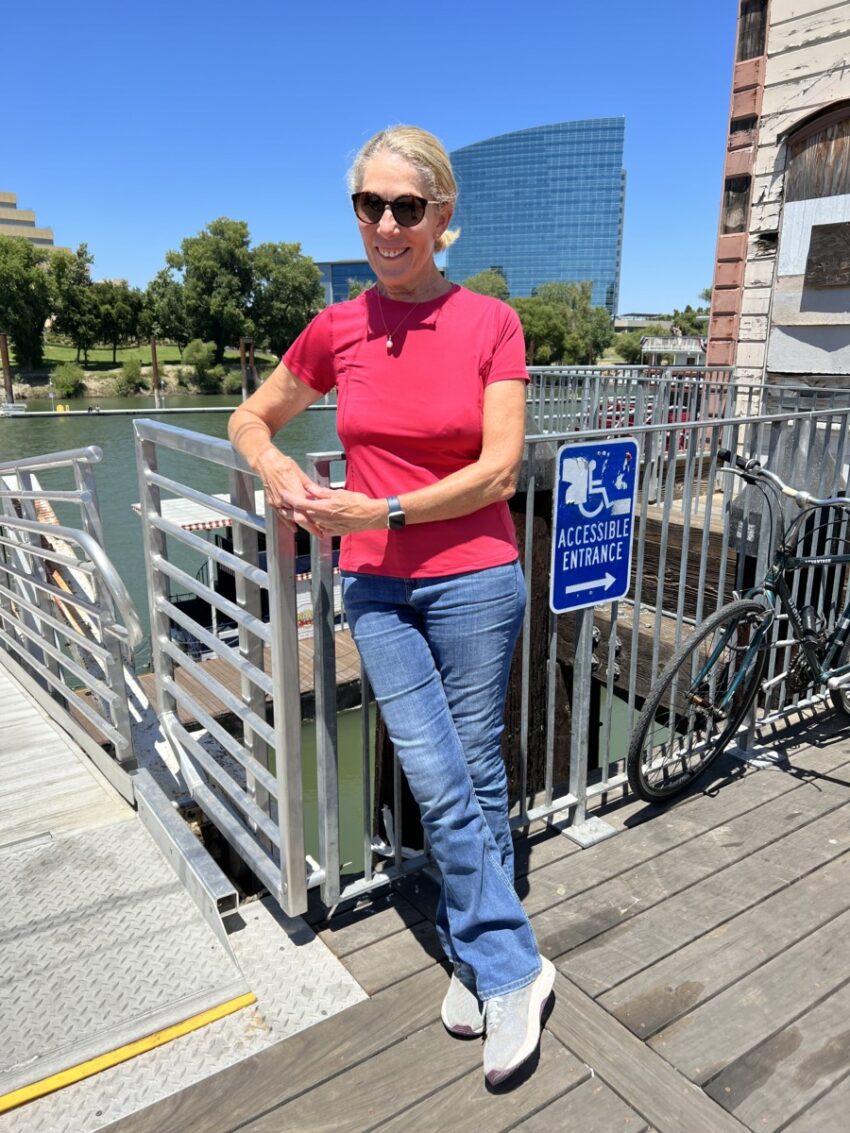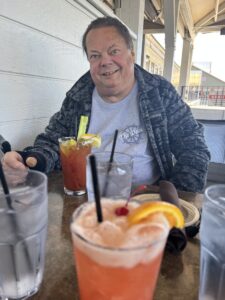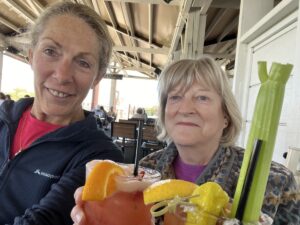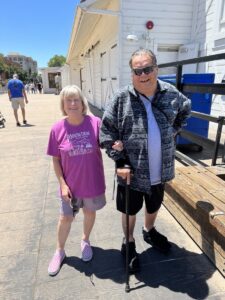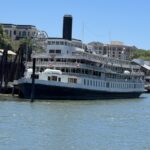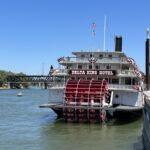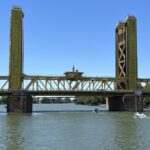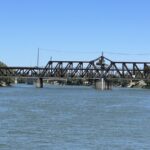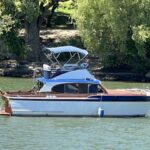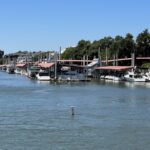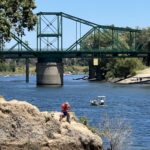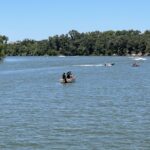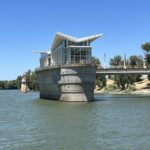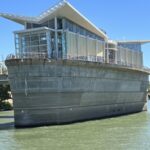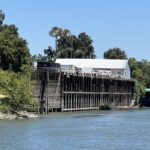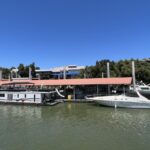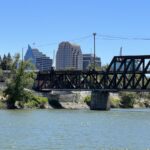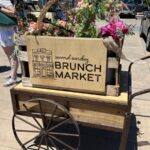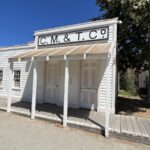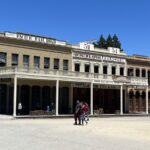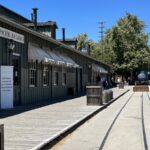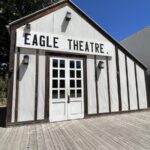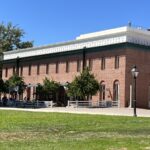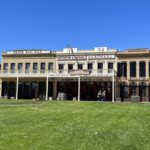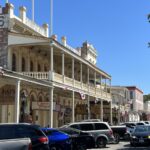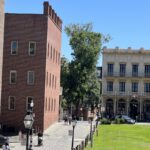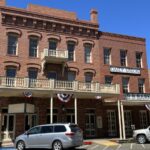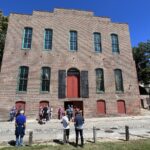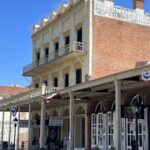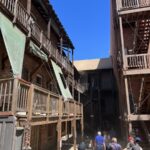After a great ride along very quiet roads, past wind farms, corn crops and fields of sunflowers we hit the freeway to Sacramento, capital of the U.S. state of California, which lies at the confluence of the Sacramento River and American River. The district of Old Sacramento harkens back to the city’s Gold Rush era, with wooden sidewalks and wagon rides. One of several museums in Old Sacramento, the California State Railroad Museum depicts the construction of the Transcontinental Railroad, one of the country’s earliest technological feats.
On arrival, brunch was in order with my good friends Bob and Judith who were also celebrating 46 years of marriage today. That celebration also included the mandatory cocktails at the Rio City Cafe.
What better way to relax and see the city than on a river boat cruise. We left the jetty just by the Tower Bridge, which is a vertical lift bridge across the Sacramento River, linking West Sacramento in Yolo County to the west, with the capital of California, Sacramento, in Sacramento County to the east. It has also been known as M Street Bridge.
From there we went under the I Street Bridge which is a historic metal truss swing bridge which crosses the Sacramento River to link the capital city of Sacramento, California with Yolo County to the west. Built in 1911, this historic bridge has a vertical clearance of 14 feet 8 inches (4.47 m) and was originally part of State Route 16. It also carries two walkways; one on either side of the roadway.
The lower level of the bridge provides rail access to Sacramento from points south and west; the upper level provides highway access.
It was built to replace an 1867 timber Howe truss swing span bridge, which also carried both railroad and road traffic.
We passed many boat marinas and a building that looks like a concrete boat and is actually a ship-shaped water intake facility. It contains distinctive glass architecture (featuring a mobile within the rotunda!) and spectacular views of the city and river, including the historic Tower and I Street Bridges and the downtown skyline.
The boat journey was very pleasant and on our return, Judith had organised a historic walking tour. We started at the Sacramento History Museum which is a reproduction of the 1854 City Hall and Waterworks building. The original building was completed in the spring of 1854 and was the city’s first municipal structure. It housed the City Waterworks, City Offices – including the Mayor’s office and Fire Department – the City Jail, and Police Court.
The tour included exploring excavated foundations and enclosed pathways hidden since Sacramento raised its streets over a century ago after major flooding. The tour guide explained how the streets and buildings were “Jacked Up!” to avoid further flooding and we then explored two spaces that were created by the city’s successful raising process. The tour also included hollow sidewalks, sloped alleyways, and the Underground spaces themselves. The history of Sacramento, California, began with its founding by Samuel Brannan and John Augustus Sutter, Jr. in 1848 around an embarcadero that his father John Sutter, Sr. constructed at the confluence of the American and Sacramento Rivers a few years prior.
When John Sutter arrived in the provincial colonial capital of Monterey in 1839, governor Juan Bautista Alvarado provided Sutter with the land he asked for, and Sutter established New Helvetia which he controlled absolutely with a private army and relative autonomy from the newly independent Mexican government.
The California Gold Rush started when gold was discovered at Sutter’s Mill, one of Sutter, Sr.’s assets in the city of Coloma in 1848; the arrival of prospectors in droves ruined Sutter’s New Helvetia and trade began to develop around a wharf he had established where the American and Sacramento Rivers joined. In the region where Sutter had planned to establish the city of Sutterville, Sacramento City was founded; Sutter, Sr. put his son in charge in frustration, and Sutter, Jr. worked to organise the city in its growth. However, its location caused the city to periodically fill with water. Fires would also sweep through the city. To resolve the problems, the city worked to raise the sidewalks and buildings and began to replace wooden structures with more resilient materials, like brick and stone. The city was selected as the state capital in 1854 after Mariano Guadalupe Vallejo failed to convince the state government to remain in the city of his namesake.
Old Sacramento State Historic Park occupies around one third of the property within the Old Sacramento Historic District of Sacramento, California. The Old Sacramento Historic District is a U.S. National Historic Landmark District. The Historic District is sometimes abbreviated as Old Sacramento, or Old Sac, and since the 1960s has been restored and developed as a significant tourist attraction. As I previously mentioned before Sacramento’s extensive levee system was in place, the area flooded quite regularly. Because of this, the city’s streets were raised a level. Most of the sidewalks and storefronts have been filled in; however, many tunnels still remain throughout Old Sacramento and the downtown area.
Today, the Old Sacramento Historic District covers the area between the river frontage and Interstate 5, between I Street and the Capitol Mall. The State Historic Park comprises about a third of the total acreage of the district including half of the waterfront, a large grassy area and railroad features. Virtually all the buildings in this area date from the 19th century, the most notable dating back to the period immediately after the disastrous fire of 1852, and show a reasonable approximation of their original appearance, though they have required varying degrees of reconstruction to restore to them to that state. However, few if any still serve their original purpose, most of them now house restaurants, gift shops, or other businesses catering to tourists.
While the architecture from this period is commonly attributed to Victorian gold miners, characteristics of West End, such as multi-storied buildings, large arched doorways, full-height balcony windows and the use of decorative wrought-iron balconies, were most ubiquitous in parts of Spain and the Spanish colonies. This influence may be attributed to the fact that the period of Spanish, then Mexican, rule in California, enjoyed immigration from all over the Atlantic, including Spain and the Canary Islands, and the Spanish colonies.
The architecture of Old Town Sacramento (formerly known as West End) exhibits observable characteristics similar to that of San Juan (Puerto Rico), Havana (Cuba), Tampico (Mexico), Seville (Spain), Santa Cruz de Teneriffe (Canary Islands), Madrid (Spain).
Notable buildings include:
- B.F. Hastings Building, the National Historic Landmarked western terminal of the Pony Express and the first location of the California Supreme Court; also housed the office of the Alta California Telegraph Company; features a branch of the Wells Fargo History Museum
- Big Four House, a National Historic Landmarked building constructed through the joint efforts of California’s railroad pioneers: Collis Huntington, Mark Hopkins, Leland Stanford and Charles Crocker, known as The Big Four.
- Lady Adams Building- oldest non-residential building in Old Sacramento and is California Historic Landmark No. 603.
- Sacramento Engine Company No. 3, the oldest remaining firehouse in Sacramento
- The Firehouse Restaurant (1853), redbrick firehouse; (1960) restaurant
- Old Sacramento Schoolhouse Museum
- Eagle Theatre – only survived from 1849 to 1850 but has been reconstructed
- Booth Buildings hens
- Booth’s residence on Front Street, the first U.S. governor’s mansion in California.
- Morse Building
The first two are also individually designated National Historic Landmarks.
A fabulous day with such an informative narrative from our guide about the history of Sacramento. Off home to have a curry and the regulatory glass of bubbles!!!
Thank you Bob and Judith for a wonderful few days.

